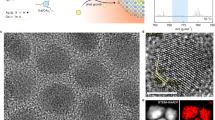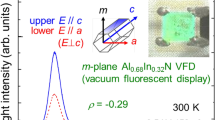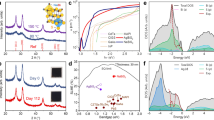Abstract
Strong optical absorption by a semiconductor is a highly desirable property for many optoelectronic and photovoltaic applications. The optimal thickness of a semiconductor absorber is primarily determined by its absorption coefficient. To date, this parameter has been considered as a fundamental material property, and efforts to realize thinner photovoltaics have relied on light-trapping structures that add complexity and cost. Here we demonstrate that engineering cation disorder in a ternary chalcogenide semiconductor leads to considerable absorption increase due to enhancement of the optical transition matrix elements. We show that cation-disorder-engineered AgBiS2 colloidal nanocrystals offer an absorption coefficient that is higher than other photovoltaic materials, enabling highly efficient extremely thin absorber photovoltaic devices. We report solution-processed, environmentally friendly, 30-nm-thick solar cells with short-circuit current density of 27 mA cm−2, a power conversion efficiency of 9.17% (8.85% certified) and high stability under ambient conditions.
This is a preview of subscription content, access via your institution
Access options
Access Nature and 54 other Nature Portfolio journals
Get Nature+, our best-value online-access subscription
$29.99 / 30 days
cancel any time
Subscribe to this journal
Receive 12 print issues and online access
$209.00 per year
only $17.42 per issue
Buy this article
- Purchase on Springer Link
- Instant access to full article PDF
Prices may be subject to local taxes which are calculated during checkout




Similar content being viewed by others
Data availability
The experimental and computational data that support the current study are available in a public repository (https://doi.org/10.5281/zenodo.5733213). Supplementary Information data are available from the corresponding author upon reasonable request.
Code availability
The code that supports this study is available in a public repository (https://doi.org/10.5281/zenodo.5733213).
Change history
25 March 2022
A Correction to this paper has been published: https://doi.org/10.1038/s41566-022-00990-4
References
Bernechea, M. et al. Solution-processed solar cells based on environmentally friendly AgBiS2 nanocrystals. Nat. Photon. 10, 521–525 (2016).
Boles, M. A., Ling, D., Hyeon, T. & Talapin, D. V. The surface science of nanocrystals. Nat. Mater. 15, 364–364 (2016).
Green, M. A. & Bremner, S. P. Energy conversion approaches and materials for high-efficiency photovoltaics. Nat. Mater. 16, 23–34 (2017).
Massiot, I., Cattoni, A. & Collin, S. Progress and prospects for ultrathin solar cells. Nat. Energy 5, 959–972 (2020).
Chen, H.-L. et al. A 19.9%-efficient ultrathin solar cell based on a 205-nm-thick GaAs absorber and a silver nanostructured back mirror. Nat. Energy 4, 761–767 (2019).
Adhyaksa, G. W. P., Johlin, E. & Garnett, E. C. Nanoscale back contact perovskite solar cell design for improved tandem efficiency. Nano Lett. 17, 5206–5212 (2017).
Bosson, C. J. et al. Cation disorder and phase transitions in the structurally complex solar cell material Cu2ZnSnS4. J. Mater. Chem. A 5, 16672–16680 (2017).
Chen, W., Dahliah, D., Rignanese, G.-M. & Hautier, G. Origin of the low conversion efficiency in Cu2ZnSnS4 kesterite solar cells: the actual role of cation disorder. Energy Environ. Sci. 14, 3567–3578 (2021).
Malerba, C., Valentini, M. & Mittiga, A. Cation disorder in Cu2ZnSnS4 thin films: effect on solar cell performances. Sol. RRL 1, 1700101 (2017).
Li, J. et al. Defect control for 12.5% efficiency Cu2ZnSnSe4 kesterite thin-film solar cells by engineering of local chemical environment. Adv. Mater. 32, e2005268 (2020).
Zawadzki, P., Zakutayev, A. & Lany, S. Entropy-driven clustering in tetrahedrally bonded multinary materials. Phys. Rev. Appl. 3, 034007 (2015).
Mohan, R. Green bismuth. Nat. Chem. 2, 336–336 (2010).
Vesborg, P. C. K. & Jaramillo, T. F. Addressing the terawatt challenge: scalability in the supply of chemical elements for renewable energy. RSC Adv. 2, 7933–7947 (2012).
Burgués-Ceballos, I., Wang, Y., Akgul, M. Z. & Konstantatos, G. Colloidal AgBiS2 nanocrystals with reduced recombination yield 6.4% power conversion efficiency in solution-processed solar cells. Nano Energy 75, 104961 (2020).
Kopula Kesavan, J. et al. Cation disorder and local structural distortions in AgxBi1–xS2 nanoparticles. Nanomaterials 10, 316 (2020).
Schnepf, R. R. et al. Utilizing site disorder in the development of new energy-relevant semiconductors. ACS Energy Lett. 5, 2027–2041 (2020).
Yang, W.-C., Miskin, C. K., Carter, N. J., Agrawal, R. & Stach, E. A. Compositional inhomogeneity of multinary semiconductor nanoparticles: a case study of Cu2ZnSnS4. Chem. Mater. 26, 6955–6962 (2014).
Hao, M. et al. Ligand-assisted cation-exchange engineering for high-efficiency colloidal Cs1−xFAxPbI3 quantum dot solar cells with reduced phase segregation. Nat. Energy 5, 79–88 (2020).
Ju, M.-G., Dai, J., Ma, L., Zhou, Y. & Zeng, X. C. AgBiS2 as a low-cost and eco-friendly all-inorganic photovoltaic material: nanoscale morphology–property relationship. Nanoscale Adv. 2, 770–776 (2020).
Viñes, F., Bernechea, M., Konstantatos, G. & Illas, F. Matildite versus schapbachite: first-principles investigation of the origin of photoactivity in AgBiS2. Phys. Rev. B 94, 235203 (2016).
Guin, S. N., Banerjee, S., Sanyal, D., Pati, S. K. & Biswas, K. Origin of the order–disorder transition and the associated anomalous change of thermopower in AgBiS2 nanocrystals: a combined experimental and theoretical study. Inorg. Chem. 55, 6323–6331 (2016).
Khan, M. D. et al. Electrochemical investigation of uncapped AgBiS2 (schapbachite) synthesized using in situ melts of xanthate precursors. Dalton Trans. 48, 3714–3722 (2019).
Ren, X. et al. In situ exsolution of Ag from AgBiS2 nanocrystal anode boosting high-performance potassium-ion batteries. J. Mater. Chem. A 8, 15058–15065 (2020).
Liu, M. et al. Hybrid organic–inorganic inks flatten the energy landscape in colloidal quantum dot solids. Nat. Mater. 16, 258–263 (2017).
Kagan, C. R. & Murray, C. B. Charge transport in strongly coupled quantum dot solids. Nat. Nanotechnol. 10, 1013–1026 (2015).
Wong, J., Omelchenko, S. T. & Atwater, H. A. Impact of semiconductor band tails and band filling on photovoltaic efficiency limits. ACS Energy Lett. 6, 52–57 (2021).
Treharne, R. E. et al. Optical design and fabrication of fully sputtered CdTe/CdS solar cells. J. Phys. Conf. Ser. 286, 012038 (2011).
ElAnzeery, H. et al. Refractive index extraction and thickness optimization of Cu2ZnSnSe4 thin film solar cells. Phys. Status Solidi A 212, 1984–1990 (2015).
Palik, E. D. Handbook of Optical Constants of Solids (Academic Press, 1998).
Manzoor, S. et al. Optical modeling of wide-bandgap perovskite and perovskite/silicon tandem solar cells using complex refractive indices for arbitrary-bandgap perovskite absorbers. Opt. Express 26, 27441–27460 (2018).
Chen, C. et al. Characterization of basic physical properties of Sb2Se3 and its relevance for photovoltaics. Front. Optoelectron. 10, 18–30 (2017).
Pettersson, L. A. A., Roman, L. S. & Inganäs, O. Modeling photocurrent action spectra of photovoltaic devices based on organic thin films. J. Appl. Phys. 86, 487–496 (1999).
Centurioni, E. Generalized matrix method for calculation of internal light energy flux in mixed coherent and incoherent multilayers. Appl. Opt. 44, 7532–7539 (2005).
Guillemoles, J.-F., Kirchartz, T., Cahen, D. & Rau, U. Guide for the perplexed to the Shockley–Queisser model for solar cells. Nat. Photon. 13, 501–505 (2019).
Gilmore, R. H. et al. Epitaxial dimers and Auger-assisted detrapping in PbS quantum dot solids. Matter 1, 250–265 (2019).
Bagus, P. S., Illas, F., Pacchioni, G. & Parmigiani, F. Mechanisms responsible for chemical shifts of core-level binding energies and their relationship to chemical bonding. J. Electron. Spectrosc. Relat. Phenom. 100, 215–236 (1999).
Tambo, T. & Tatsuyama, C. XPS study on the chemical shifts of crystalline III–VI layered compounds. J. Phys. Soc. Jpn 54, 4382–4389 (1985).
Akgul, M. Z., Figueroba, A., Pradhan, S., Bi, Y. & Konstantatos, G. Low-cost RoHS compliant solution processed photovoltaics enabled by ambient condition synthesis of AgBiS2 nanocrystals. ACS Photonics 7, 588–595 (2020).
Hu, L. et al. Enhanced optoelectronic performance in AgBiS2 nanocrystals obtained via an improved amine-based synthesis route. J. Mater. Chem. C 6, 731–737 (2018).
Oh, J. T. et al. Water-resistant AgBiS2 colloidal nanocrystal solids for eco-friendly thin film photovoltaics. Nanoscale 11, 9633–9640 (2019).
Pan, H. et al. Advances in design engineering and merits of electron transporting layers in perovskite solar cells. Mater. Horiz. 7, 2276–2291 (2020).
Irfan et al. Energy level evolution of air and oxygen exposed molybdenum trioxide films. Appl. Phys. Lett. 96, 243307 (2010).
Yu, B.-B. et al. Heterogeneous 2D/3D Tin-halides perovskite solar cells with certified conversion efficiency breaking 14%. Adv. Mater. 33, 2102055 (2021).
Jiang, X. Ultra-high open-circuit voltage of tin perovskite solar cells via an electron transporting layer design. Nat. Commun. 7, 1245 (2020).
Choi, Y. C., Lee, D. U., Noh, J. H., Kim, E. K. & Seok, S. I. Highly improved Sb2S3 sensitized-inorganic–organic heterojunction solar cells and quantification of traps by deep-level transient spectroscopy. Adv. Funct. Mater. 24, 3587–3592 (2014).
Wu, C. et al. Water additive enhanced solution processing of alloy Sb2(S1−xSex)3-based solar cells. Sol. RRL 4, 1900582 (2020).
Huber, S. P. et al. AiiDA 1.0, a scalable computational infrastructure for automated reproducible workflows and data provenance. Sci. Data 7, 300 (2020).
Kresse, G. & Hafner, J. Ab initio molecular dynamics for liquid metals. Phys. Rev. B 47, 558–561 (1993).
Kresse, G. & Furthmüller, J. Efficiency of ab-initio total energy calculations for metals and semiconductors using a plane-wave basis set. Comput. Mater. Sci. 6, 15–50 (1996).
Kresse, G. & Furthmüller, J. Efficient iterative schemes for ab initio total-energy calculations using a plane-wave basis set. Phys. Rev. B 54, 11169–11186 (1996).
Blöchl, P. E. Projector augmented-wave method. Phys. Rev. B 50, 17953–17979 (1994).
Zunger, A., Wei, S.-H., Ferreira, L. G. & Bernard, J. E. Special quasirandom structures. Phys. Rev. Lett. 65, 353–356 (1990).
van de Walle, A., Asta, M. & Ceder, G. The alloy theoretic automated toolkit: a user guide. Calphad 26, 539–553 (2002).
van de Walle, A. et al. Efficient stochastic generation of special quasirandom structures. Calphad 42, 13–18 (2013).
Geller, S. & Wernick, J. H. Ternary semiconducting compounds with sodium chloride-like structure: AgSbSe2, AgSbTe2, AgBiS2, AgBiSe2. Acta Crystallogr. 12, 46–54 (1959).
Heyd, J., Scuseria, G. E. & Ernzerhof, M. Hybrid functionals based on a screened Coulomb potential. J. Chem. Phys. 118, 8207–8215 (2003).
Borlido, P. et al. Exchange-correlation functionals for band gaps of solids: benchmark, reparametrization and machine learning. npj Comput. Mater. 6, 96 (2020).
Krukau, A. V., Vydrov, O. A., Izmaylov, A. F. & Scuseria, G. E. Influence of the exchange screening parameter on the performance of screened hybrid functionals. J. Chem. Phys. 125, 224106 (2006).
Skelton, J. JMSkelton Transformer. https://github.com/JMSkelton/Transformer (2021).
Perdew, J. P. et al. Restoring the density-gradient expansion for exchange in solids and surfaces. Phys. Rev. Lett. 100, 136406 (2008).
Csonka, G. I. et al. Assessing the performance of recent density functionals for bulk solids. Phys. Rev. B 79, 155107 (2009).
Diedenhofen, S. L., Bernechea, M., Felter, K. M., Grozema, F. C. & Siebbeles, L. D. A. Charge photogeneration and transport in AgBiS2 nanocrystal films for photovoltaics. Sol. RRL 3, 1900075 (2019).
Cao, Y., Stavrinadis, A., Lasanta, T., So, D. & Konstantatos, G. The role of surface passivation for efficient and photostable PbS quantum dot solar cells. Nat. Energy 1, 16035 (2016).
Hoye, R. L. Z. et al. Perovskite-inspired photovoltaic materials: toward best practices in materials characterization and calculations. Chem. Mater. 29, 1964–1988 (2017).
Huang, Y.-T., Kavanagh, S. R., Scanlon, D. O., Walsh, A. & Hoye, R. L. Z. Perovskite-inspired materials for photovoltaics and beyond—from design to devices. Nanotechnology 32, 132004 (2021).
Zheng, Q. QijingZheng/VaspBandUnfolding. https://github.com/QijingZheng/VaspBandUnfolding (2021).
Popescu, V. & Zunger, A. Extracting E versus \(\overrightarrow {k}\) effective band structure from supercell calculations on alloys and impurities. Phys. Rev. B 85, 085201 (2012).
Whalley, L. D. effmass: an effective mass package. J. Open Source Softw. 3, 797 (2018).
Jackson, A. J., Ganose, A. M., Regoutz, A., Egdell, R. G. & Scanlon, D. O. Galore: broadening and weighting for simulation of photoelectron spectroscopy. J. Open Source Softw. 3, 773 (2018).
Nelson, R. et al. LOBSTER: local orbital projections, atomic charges, and chemical-bonding analysis from projector-augmented-wave-based density-functional theory. J. Comput. Chem. 41, 1931–1940 (2020).
Morgan, B. J. vasppy. https://doi.org/10.5281/zenodo.4460130 (2021).
Ong, S. P. et al. Python materials genomics (pymatgen): a robust, open-source Python library for materials analysis. Comput. Mater. Sci. 68, 314–319 (2013).
Acknowledgements
G.K. acknowledges financial support from the European Research Council (ERC) under the European Union’s Horizon 2020 research and innovation programme (grant agreement no. 725165), the Fundació Joan Ribas Araquistain (FJRA), the Fundació Privada Cellex, the program CERCA, EQC2019-005797-P (AEI/FEDER UE), 2017SGR1373 and ‘Severo Ochoa’ Centre of Excellence CEX2019-000910-S funded by the Spanish State Research Agency. Y.W. acknowledges support from the European Union’s Horizon 2020 research and innovation programme under the Marie Skłodowska-Curie grant agreement no. 754558. I.B.-C. acknowledges support from the Government of Catalonia’s Beatriu de Pinós postdoctoral programme (grant no. 2017BP00241). S.R.K. thanks L. Harnett-Caulfield for help with using the alloy theoretic automated toolkit software package and Y.-S. Choi for help with calculating the Madelung potentials; he also acknowledges the EPSRC Centre for Doctoral Training in the Advanced Characterisation of Materials (CDT-ACM) (EP/S023259/1) for funding a PhD studentship. A.W. and D.O.S. acknowledge the use of the UCL Kathleen High Performance Computing Facility (Kathleen@UCL), the Imperial College Research Computing Service and associated support services. By the membership of the UK’s HEC Materials Chemistry Consortium, which is funded by the EPSRC (EP/L000202, EP/R029431 and EP/T022213), this work used the ARCHER2 UK National Supercomputing Service and the UK Materials and Molecular Modelling (MMM) Hub (Thomas EP/P020194 and Young EP/T022213). D.O.S. acknowledges support from the EPSRC (EP/N01572X/1) and the European Research Council, ERC (grant no. 758345).
Author information
Authors and Affiliations
Contributions
G.K. supervised and directed the study. Y.W. and G.K. conceived the idea, designed this study and co-wrote the manuscript, with feedback from the co-authors. Y.W. synthesized the AgBiS2 NCs, performed the material characterization, fabricated and characterized the solar cells, and analysed the data, with help from I.B.-C. Y.W. performed the optical modelling. S.R.K. designed and conducted the theoretical modelling, analysed the DFT simulations, interpreted the data, provided insights and contributed to manuscript writing. D.S and A.W. supervised the theoretical modelling.
Corresponding author
Ethics declarations
Competing interests
The authors declare no competing interests.
Peer review
Peer review information
Nature Photonics thanks Rui Zhu, Sergio Brovelli and the other, anonymous, reviewer(s) for their contribution to the peer review of this work.
Additional information
Publisher’s note Springer Nature remains neutral with regard to jurisdictional claims in published maps and institutional affiliations.
Supplementary information
Supplementary Information
Supplementary Figs. 1–23, Note, Tables 1 and 2 and references.
Rights and permissions
About this article
Cite this article
Wang, Y., Kavanagh, S.R., Burgués-Ceballos, I. et al. Cation disorder engineering yields AgBiS2 nanocrystals with enhanced optical absorption for efficient ultrathin solar cells. Nat. Photon. 16, 235–241 (2022). https://doi.org/10.1038/s41566-021-00950-4
Received:
Accepted:
Published:
Issue Date:
DOI: https://doi.org/10.1038/s41566-021-00950-4
This article is cited by
-
Silver telluride colloidal quantum dot infrared photodetectors and image sensors
Nature Photonics (2024)
-
Composite and Pristine Silver Bismuth Sulphide: Synthesis and Up-to-Date Applications
Journal of Inorganic and Organometallic Polymers and Materials (2024)
-
Mixed integer programming with kriging surrogate model technique for dispersion control of photonic crystal fibers
Optical and Quantum Electronics (2024)
-
A numerical approach for optimization of bismuth-based photo absorbers for solar cell applications
Journal of Optics (2024)
-
How to get high-efficiency lead chalcogenide quantum dot solar cells?
Science China Physics, Mechanics & Astronomy (2023)



